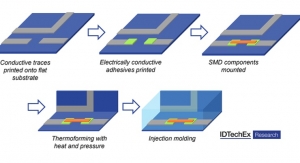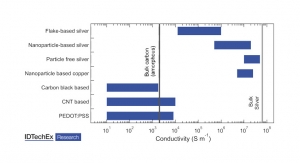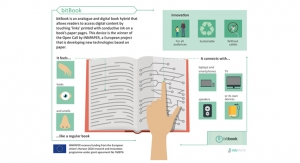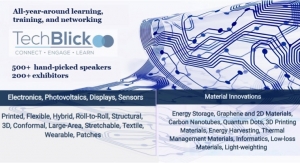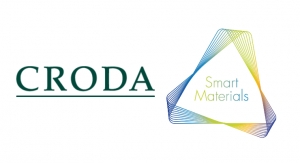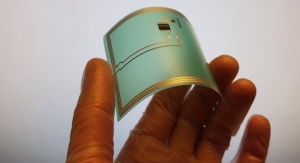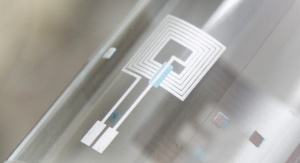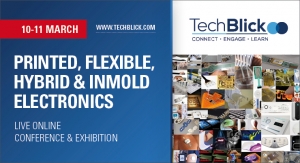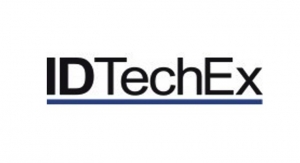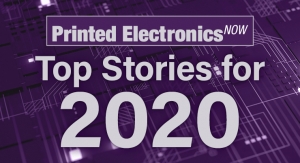David Savastano, Editor11.07.14
The market for printed and flexible electronics is showing signs of growth, as companies are developing new products that offer advantages to brand owners and end users alike. As new products, whether they are displays, printed sensors and smart packaging, printed automotive consoles and heating elements, printed RFID tags, photovoltaics (PV), medical test strips and many other reach the market, more companies see the potential for printed electronics.
The advantages of printed electronics are numerous. The first, of course, is cost and manufacturing efficiency. Being able to produce circuitry on a printing press, either sheetfed or roll-to-roll, is a tremendous cost savings. Creating a product that is flexible also offers new opportunities and form factors.
However, there are technical hurdles to overcome, and conductive inks are one area where a great deal of research has been conducted. As a result, there have been numerous advances in a wide range of disciplines, from metallics to nanoparticle inks, and conductive ink manufacturers say that their sales are growing.
T-Ink has built up an impressive range of projects during the past 10 years. The company has developed more than 2,000 ink formulations for PE projects, and has numerous products in the pipeline. Its T-Ink Smart Surface 3D In-mold Overhead Console, which features screen printed capacitive switches, made its debut in this year’s Ford Fusion.
Terry Kaiserman, co-founder and chief technical officer for T-Ink, Inc., said T-Ink enjoyed growth during the past year as more of its products reached commercialization.
“The release of the 2013 Ford Fusion using our part in the Overhead Console has given printed electronics enormous credibility,” Kaiserman said. “More and more companies are coming to providers of PE to lower costs, improve performance, lower weight and reduce form factor and, of course, lessen the amount of materials on their bill of materials (BOM). The future of PE is bright and growing, not without its challenges though, but growing none the less.”
“Overall, Sun Chemical saw growth in the conductive inks and printed electronics markets, thanks primarily to the high demand in certain applications, such as permanent and disposable sensors for both the industrial and medical industries,” Roy Bjorlin, global commercial director, electronic materials, Sun Chemical, said. “Due to overcapacity, there was a drop in demand for conventional c-Si photovoltaics.”
“We continue to see our revenues growing, with both the sale of our PulseForge tools as well as our Metalon conductive inks,” said Stan Farnsworth, vice president of marketing for NovaCentrix. “At the end of 2012, we launched our newest PulseForge tool, the PulseForge 1200, for R&D use. This product is addressing the opportunity for R&D users who wish to have access to the sophisticated features of the full-scale PulseForge tools but are not ready for the production capabilities of those larger tools. The low price point for the new 1200 puts that state-of-the-art capability into the hands of exploratory users and developers in printed electronics. We are very pleased at the excellent market response we have received, and within four weeks of launching the tool we are already shipping them to customers.
“While it is true that many organizations who are working in the printed electronics area are at the R&D phase, it is also true that many of those have intentions to scale their efforts into full production volumes,” Farnsworth added. “Those groups especially appreciate the lineage of the PulseForge tools – that the process conditions developed on the smaller 1200 will translate directly to application with the full size tools to mitigate scale-up risk.”
Dr. Zvi Yaniv, president and CEO of Applied Nanotech, Inc. (ANI), said that Applied Nanotech’s expertise is in inks and pastes for the printed electronics industry, manufacturing aluminum pastes, silver inks/pastes, nickel inks/pastes and copper inks/pastes.
“We see the market growing,” said Dr. Yaniv. “The strongest growth area is in solar cell printing using aluminum and silver pastes/inks. YHCC, our strategic partner in China, installed a state-of-the-art factory for inks and pastes and is producing several thousands of kilograms for the solar market every year.”
However, these inks and pastes need to be customized for each end-user, be it in the solar cell industry or the printed electronics industry in general.
“Each of these inks/pastes that can be considered off the shelf need to go through a process of customization for particular substrates and the application,” Dr. Yaniv added. “We are learning more and more that pastes and inks can’t be sold like ketchup in a supermarket. In our case, every hamburger is different and needs its ‘special’ ketchup.”
“Not every ink will work on every application,” said Dr. Jamie Novak, director of Applied Nanotech’s NanoElectronics and Thermal Management Division. “They need to be tailor made for every customer.”
Scott Gordon, business development manager – DuPont Microcircuit Materials, reported that several new markets and applications have surfaced that utilize conductive inks.
In particular, Gordon noted two examples: screenprinted, self-limiting heaters and silver conductors for 3D thermoforming in-mold electronics.
“In each case, the applications build from general material performances dating back to the 1990s,” Gordon added.
“The variety of applications for conductive inks and printed electronics grew,” said Paul Lindquist, business development manager, Methode Electronics, Inc. “I don’t know if the actual volume of ink consumed grew due to the loss of government incentives for the photovoltaic industry, which shrunk considerably. Since that was one of the largest consumer of screen printed conductive silver, the loss of that volume may have offset gains in other areas.”
“Our sales for new printed electronic inks far exceeded my expectations, with record growth nearing eight figures during the last half of 2012,” said Steve Toyama of Engineered Conductive Materials (ECM). “ECM opened a third manufacturing site in a 55,000 square foot building and hired a whole new production crew to handle this growth. The new markets that are part of these new inks will continue to prosper for many years to come. These inks are higher margin inks and have fueled record profits for ECM.”
Dr. Ian Clark, sales and marketing director, Intrinsiq Materials Ltd., noted that the markets for conductive inks and printed electronics continued to grow during the past year, particularly in screenprinting, with photovoltaics (PV) and RFID being particularly strong opportunities.
NANOGAP-USA is a supplier of conductive particle and nanofiber dispersions to conductive ink companies. Darren Bianchi, president of NANOGAP-USA, said he is seeing growth in the market.
“We are seeing growing interest in our products from ink manufacturers as well as increased commercial uptake, indicating that the market is continuing to grow,” Bianchi said.
“One of our target applications for printed electronics, especially for conductive inks, is touch sensors and their electrodes,” said Shunsuke Nomura, Printed Electronics Department, ToyoChem. “Handset applications with touch sensors will keep growing globally to the extent of 15% to 20% annually. Other applications such as RFID and ePaper will also keep growing, so we believe the market will grow steadily.”
Beth Vasy, operations manager for Liquid X Printed Metals, Inc., said that Liquid X has noticed a considerable increase in demand for its products over the past year.
“Since the beginning of the electronic age, manufacturers have been saddled with costly and often ineffective ways to deposit metal in the production of their devices,” Vasy said. “Traditionally, metal features are created through subtractive methods such as chemical or physical vapor deposition, electroplating, sputtering and photolithography. With continuous downward cost pressure, manufacturers have been searching for more cost and performance effective methods to deposit metals and, in particular, a way to convert multi-step subtractive processes into single-step additive processes.
“‘Direct-write’ printing techniques, in which the metal is deposited in the required form and shape within a one-step process, offer just such a step change and a new set of electronic device technologies – collectively known as ‘Printed Electronics’ – are increasingly being applied to deliver new forms of electronic devices such as flexible sensors,” Vasy added.
Opportunities for Conductive Inks
There are plenty of opportunities for printed electronics, and conductive ink manufacturers are tailoring their products for these new applications.
“Our automotive initiative uses a myriad of ink types and is being used to replace conventional switches in vehicles,” Kaiserman said. “We also are working on orders for white goods, aerospace, robotics and switch replacement in medical devices. We use solvent-based and UV inks for these applications.
“Our textile initiative is also blossoming for us,” Kaiserman said. “We have developed a line of transfer heaters that are used for heating apparel. We also have sensors that are being used to pick up vital signs that are printed and/or transferred onto various textiles. We use water based and non-PVC plastisols for this application. There are other areas as well, but due to our agreements with the government, we can’t go into details.”
“One area of growth we are seeing is in flexible films such as PET films with printed features on them,” Dr. Yaniv said. “For example, architectural windows are becoming a very interesting surface. Metallic conductive traces for EMI shielding, sensors, integrated solar cells, etc., are considered for printing directly onto windows or films attached to windows. Furthermore, we all believe the market is progressing.”
“For years there has been a lot of focus directed towards applications requiring nano inks, printed transistors and high speed roll-to-roll printing, and those technologies may still reach commercial success,” Gordon said. “However, we are seeing a number of new commercial applications that can utilize either existing off-the-shelf materials, or variations requiring just slight customization.”
Vasy said that the potential markets for conductive metallic inks are vast as technology continues to grow and play an important role in our everyday lives.
“Liquid X has been contacted by companies involved in markets ranging from the transparent conductors to graphics arts,” Vasy noted. “Additional markets in which we have experience strong customer pull include printed circuit boards, biosensors, solar cells, smart packaging and sensors for the automotive industry.”
“We are starting to see opportunities due to the partnering of fluid manufacturers such as Methode with printer manufacturers, curing equipment manufacturers and other potential co-suppliers to the printed electronics market,” Lindquist said. “The partnering that is taking place across the market is pulling the pieces together, making it easier for the end user to obtain prototypes, and implement manufacturing for printed electronics applications.”
“We are seeing significant growth for permanent and disposable sensors in both the industrial and medical industries,” Bjorlin noted. “There is also great promise in the lighting market, with EL and OLED driving the technology for conductive inks and supporting materials such as white background inks and barrier coatings.
“We are encouraged by the success we are seeing in the applications we have focused on that align with our technology road map, including materials to support higher efficiency photovoltaics, such as selective emitter, interdigitated back-contact (IBC) and thin film PV,” Bjorlin added. “Growth in other applications such as display, sensors and lighting are all positive.”
“Silver nanofiber inks for transparent conductive films for touchscreens is an important market for NANOGAP,” Bianchi said. “The growing use of silver nanofiber and nanowire products as an ITO replacement is evidence of the start of commercial success.”
“In general, photovoltaics (PV) and automotive are the most important markets for conductive inks,” Gordon said. “PV includes the standard silicon wafer type and several types of thin film PV, while automotive includes under-the-hood electronics on ceramic substrates, rear window defoggers and interior applications.”
“For conductive inks, RFID tags, cards and touch sensor applications will be more important markets,” Nomura noted. “The printing method as mass production system became mature and its process cost reduction reliability will benefit price competitiveness for daily use products directly.”
“Photovoltaic, RFID, sensors, displays and touch screens are all important applications for conductive inks,” Lindquist added.
Toyama noted that ECM markets to production friendly, high yield and low cost device manufacturers using screen printable or gravure applied conductive inks.
“We have tried nozzle, inkjet and flexo conductive inks, but we keep coming back to screen printable inks as the most cost effective and production friendly process we have found so far,” Toyama added. “ We will jump into other markets like inkjet once this technology overcomes cost and yield hurdles.”
“There is increasing interest from device manufacturers looking to replace silver with copper or conventional PCB with copper screen printing,” Clark said.
“Because of the very low price point of our Metalon ICI copper oxide reduction inks, we continue to have a very strong response from the RFID community,” Farnsworth said.
“The trend over the last couple of years is not just to develop component-level technologies, such as batteries, inks, substrates and processing capabilities, but to integrate those into more complex assemblies,” Farnsworth added. “Several companies have taken the lead in these activities, with publicized cooperation at industry events such as at the IDTechEx events and at LOPE-C. This is a key sign of the maturing of the industry. In 2013, I’m also expecting additional announcements of cooperative relationships towards making printed electronics applications more available.”
“In our business, it is only about innovation and new developments,” Kaiserman added. “We have tried to be a pioneer in applying our technology expertise in PE most times with success, but sometimes not. We have enjoyed the opportunities our customers bring to us and many of them are on the way to commercialization. As you know, new innovation takes time to manifest into final products so our business model allows for one to four years of development time. We feel our future in innovation is solid, the new products are sound and some may allow our inventions to become ubiquitous in the years to come.”
Key Properties for Conductive Inks
Conductive ink performance is critical, and it has improved dramatically in recent years.
“Ink performance from a conductivity perspective has now gotten to the point of meeting the needs of many types of applications,” Farnsworth said.
“In nanofiber inks, the desired properties are low sheet resistance coupled with high light transmission and low haze,” Bianchi said. “In nanoparticle-based inks, low temperature sintering and long term ink stability are key properties.”
“Fine line capability and faster printing speeds are important,” Bjorlin said. “However, we also feel that supporting materials such as barrier coatings will enable more applications in the lighting, sensors, and thin film PV markets.”
“Customers have always sought out performance improvements from their ink suppliers, including printed resistance, line resolution, adhesion and lower curing temperature,” Gordon said. “Many of these requests result in custom product requests, requiring the experienced ink supplier to define and obtain the key raw materials for product development, and ultimately scale the products into reproducible high volume production batch sizes that will be available for many years.”
However, there are other needs as well. For example, Farnsworth noted that adhesion is an important factor.
“One of the key topics now is the adhesion of those inks to a variety of substrates,” Farnsworth said. “Success here in the wider adoption of inks will require not just continued formulation work by the ink suppliers, but also taking the ink strengths and weaknesses into account by the product designers and ink users. This may involve the user engineers considering the use of alternative substrate materials to perhaps their initial design plan.
“Often the user engineers are not aware of the benefits of using alternative substrate materials simply because for so long in their areas those materials were not a viable option due to performance constraints such as chemical resistance (for etch-based patterning) or temperature resistance (for traditional thermal curing),” Farnsworth added. “With the use of additive print methods and photonic curing, many types of substrates can become viable.”
Vasy said that printed electronics manufacturers are looking for conductive inks that have a wide range of characteristics, which can be systematically varied depending upon end use.
“Because Liquid X inks are particle-free, they provide customers with numerous advantages,” Vasy said. “Across the board, our customers are interested in an ink with high conductivity which we are able to achieve even with very thin layers. Thickness affects the amount of precious metal that is used, thus overall costs. Another important characteristic of conductive inks are curing temperature as this will affect the types of substrates that are applicable. Adhesion is yet another important attribute that our customers are interested in.”
“Cost reduction has been a major request over the past few years due partly to the escalating price of silver,” Gordon noted. “DuPont has responded by introducing new composite material innovations.”
Lindquist noted that processing the inks is of particular interest to printed electronics manufacturers.
“Manufacturers would like the overall process to be faster, less expensive or offer some form or function that cannot be achieved with their current technologies,” Lindquist said. “They would like the conductive inks to function similar to the current methodology of manufacturing a part. This is driving conductive ink manufacturers to focus on the overall process and how the conductive ink can function in the process to provide a faster or less expensive overall operation instead of just focusing on the capabilities of the ink itself.”
“As new printed electronic applications emerge, customers are pushing the limits of the ink materials and processing technologies,” Gordon added. “Therefore, the ink manufacturers must be capable of providing solid, experienced technical support to optimize the quality and yield of the manufacturing processes.
“Reduced costs from both the ink and the processing (rapid photonic curing at room temperature in air for example) - basically reduced cost of ownership of the whole process,” said Clark.
“Manufacturers are asking for the lowest cost method to manufacture devices, and again this comes down to screen printing on polyester film to make flexible circuits,” Toyama said. “ECM is willing to invent products that have never been made before to satisfy the needs of our customers.”
“The most important properties are that the inks can be printed at normal or above normal press speeds, they must be easily QC’d and they must pass all performance and abuse testing,” Kaiserman said. “I’m sure all ink providers are being asked to lower costs, increase performance and to make inks that are healthier for the pressman to use and inhale.”
New Products
To meet these needs, conductive ink manufacturers are working on new developments.
“Sun Chemical and its parent company DIC offer a wide portfolio of tailor-made technical solutions for the printed electronics industry, including metallization pastes for the c-Si, thin film and printed electronics markets,” Bjorlin said. “Our focus is on a comprehensive portfolio that includes inks and coatings for e-packaging. Sun Chemical and DIC are the world’s largest graphics ink supplier and an integral part of the packaging world. We anticipate more announcements as the year progresses.”
Gordon said that DuPont continues to expand its portfolio of functional inks and pastes for the growing printed electronics industry.
“We have more than 1,000 commercial ink formulations available today, and the majority of the new products are customized for the end use application,” Gordon said. “Many of these are developed under confidentiality agreements, but we can state recent success in developing new lower cost conductor formulations that reduce the conductor’s silver content while minimizing the impact of precious metal price fluctuations. We recently announced the PE8XX series of screenprinted conductive ink materials designed for either standard thermal curing, or for the emerging photonic curing. These materials can provide low resistivity with 20% or more potential cost savings for manufacturers.”
“NovaCentrix is launching a new customer service in April: contract printing of both functional and graphical inks,” Farnsworth said. “We are installing a 60-foot production press with flexo and screen print stations, full IR and convection drying, and of course one of our newest versions of a PulseForge 3300 tool. The web width is 50 cm, so it represents the ability to rapidly produce quantities of product that are beyond the R&D scale for clients who are not yet ready to develop that capability in-house. We are also making this capability available for other ink producers, so we will not be just printing our inks on the press.”
Dr. Yaniv and Dr. Novak commented that costs associated with performance are proving to be a challenge for the printed electronics market.
“The issue is cost,” Dr. Yaniv said. “For example, in order to utilize copper conductive inks, one of the main roadblocks is the sintering process and its cost. People want lighter weight products with higher mobility and added functionality, but the polymeric substrates used for this purpose can’t withstand high sintering temperatures. Polyimide can’t go over 425°C, is not very transparent and is costly. PET is limited to a temperature range of 125°C to 150°C. If one is using printing techniques such as screen or inkjet on PET, for example, one must lower the sintering temperature substantially.”
To get around the temperature problem, conductive ink manufacturers need to use nano-sized particles, which becomes a costly proposition.
“To achieve high-quality copper conductive ink, you need to utilize copper nanoparticles, in which case the cost today will be prohibitive,” Dr. Yaniv and Dr. Novak noted. “Everyone expected that copper would take over for silver, as the bulk copper is 200 times cheaper than bulk silver. However, this is not happening yet, because in order to make good copper ink that can be sintered at 200°C or lower as required for flexible substrates, the copper particles have to be as small as 10 nanometers. To make this type of particles in volume production is still very expensive. Applied Nanotech is selling copper nano inks, but the price is very high and is comparable with that of current high quality silver inks and pastes.
“To be able to compete in the market place, we were compelled to develop copper micro ink utilizing particles larger than 1 micrometer. In volume we sell this micro copper ink at approximately $400/kg, but not every inkjet printhead can handle the particles of larger size. We are working with an inkjet printhead company to solve this problem,” Dr. Yaniv added.
“We keep developing products with various functions such as lower metal content with maintaining suitable resistivity, fine line reliability with more than 300 shots continuous productions,” said Nomura. “We also launched photo-sensitive conductive inks that can reach ultra fine line reliability competitive with existing photolithography process. Printed electronics manufactures will require fine line mass production reliability including higher yields, and our product line-ups will be the most suitable ones for them, we believe.”
Vasy said that Liquid X plans to continue developing its silver and gold inks to ensure maximum effectiveness and affordability for our customers.
“As copper is always of commercial interest, we continue development work in this area,” Vasy added. “We also hope to explore development and production of inks composed of other metals systems along with inks for metal oxide deposition.”
“Silver pastes which are deposited via screen printing have and continue to dominate the conductive inks market,” Vasy noted.
“However, silver pastes have disadvantages, such as thick layers deposits to achieve acceptable levels of conductivity.
Nanoparticle based inks provide an alternative to silver, and while they enable additional deposition methods, they too have limitations. The trace width and thickness created by nanoparticle inks are limited by the particle size. Liquid X Printed Metals has evolved a novel and proprietary approach that allows very thin deposits of metal to be deposited from a particle-free ink. The Liquid X Printed Metals inks have the unique capability that they can deliver high conductivities at thicknesses down to 15nm - at which they are also semi-transparent.”
“ECM is working on several new markets, but the Holy Grail is a screen printable, low cost, transparent, highly conductive ink,” Toyama said.
“Our multi-modal particle size dispersions technology is continuing to be developed and refined,” Bianchi noted. “It offers improved conductivity with low temperature sintering and is under evaluation in a number of applications.”
Expectations for the Future
With products heading into production and new applications emerging, printed electronics is making gains in the market. That is good news indeed for conductive ink manufacturers.
“It is clear that the evolution of electronics devices will continue to demand higher performance and lower costs,” Bjorlin said. “Solutions that include material that can be processed additively and at high speed will continue to be in demand. In addition, there will be a rapid merge of display, communications and security technology in emerging applications such as e-packaging that will drive demand for new and innovative material solutions.”
Gordon said that this is an exciting time for printed electronics.
“We expect continued growth within the newer applications, plus we foresee ongoing design innovations that will bring new cost effective solutions to several markets, including biomedical, automotive and packaging,” Gordon added.
“We see the market continuing to grow,” Bianchi said. “We are a technology-driven company, and we anticipate capitalizing on further new opportunities with new and improved products.”
“Printed electronics is the production method that will increasingly benefit environmental and economic dimensions,” Nomura said. “We believe printed electronics will be used in several types of applications.”
Farnsworth said that NovaCentrix is very optimistic about the growth of the market.
“Increasingly, we are working with end users who have specific programs with finding and release targets,” Farnsworth said. “Of course the number of exploratory users is also growing. These are signs of a healthy early-term opportunity and are typical of the classic S-curve for the adoption of emerging technologies.
“At NovaCentrix we are committed to continuing to drive the technologies forward, simultaneously supporting the exploratory users as well as the more savvy, experienced users who are already quite knowledgeable in the space and are already in production of printed electronics-based devices,” Farnsworth added.
“Printed electronics will continue to make gains in the market in the niches where the process offers function or value,” Lindquist said. “It will probably never be the largest manufacturing process utilized for electronics, but with increased developments and economies of scale, it will continue to grow as a production method.”
“With the push toward additive manufacturing to replace subtractive methods, Liquid X projects that the printed electronics market will continue to grow exponentially,” Vasy said. “We anticipate continuing to grow with the printed electronics market and becoming more involved in developing new and exciting technologies penetrating throughout the industry.”
While Dr. Yaniv and Dr. Novak are excited by the potential of printed electronics, they know there are challenges to overcome.
“Our opinion is that what we envisioned as printed electronics industry is lagging because we did not find a solution of printing high quality active devices such as transistors,” they noted. “Material and equipment manufacturers and the printed electronics users must come together and work very closely. One needs to understand what the customer needs, what kind of substrates the customer intends to work on, the conditions and the place for the printed electronics equipment in their manufacturing line, what kind of printers are able to satisfy their needs and then the ink manufacturer must work very closely with the printer manufacturer to be able to offer to the customer a ‘total solution.’ Because so many parties are involved and everyone is trying to protect their IP, we observe that the development of the printed electronics industry is slowing down.
“However, despite all these challenges, we are very, very enthusiastic about the future,” Dr. Yaniv and Dr. Novak added. “Flexible products for the mobile industry that require printed electronics processes such as flexible displays and flexible lighting will soon appear in the marketplace.”
“If you are asking for a ‘State of the Union’ type answer, I can only reply that PE is alive and well and getting healthier every year,” Kaiserman concluded. “Those that have the funding, like in any industry, should be able to weather the challenges and long lead times to revenue. It’s not easy pioneering new ground, but all of us in the PE field are changing the world for decades to come.”
The advantages of printed electronics are numerous. The first, of course, is cost and manufacturing efficiency. Being able to produce circuitry on a printing press, either sheetfed or roll-to-roll, is a tremendous cost savings. Creating a product that is flexible also offers new opportunities and form factors.
However, there are technical hurdles to overcome, and conductive inks are one area where a great deal of research has been conducted. As a result, there have been numerous advances in a wide range of disciplines, from metallics to nanoparticle inks, and conductive ink manufacturers say that their sales are growing.
T-Ink has built up an impressive range of projects during the past 10 years. The company has developed more than 2,000 ink formulations for PE projects, and has numerous products in the pipeline. Its T-Ink Smart Surface 3D In-mold Overhead Console, which features screen printed capacitive switches, made its debut in this year’s Ford Fusion.
Terry Kaiserman, co-founder and chief technical officer for T-Ink, Inc., said T-Ink enjoyed growth during the past year as more of its products reached commercialization.
“The release of the 2013 Ford Fusion using our part in the Overhead Console has given printed electronics enormous credibility,” Kaiserman said. “More and more companies are coming to providers of PE to lower costs, improve performance, lower weight and reduce form factor and, of course, lessen the amount of materials on their bill of materials (BOM). The future of PE is bright and growing, not without its challenges though, but growing none the less.”
“Overall, Sun Chemical saw growth in the conductive inks and printed electronics markets, thanks primarily to the high demand in certain applications, such as permanent and disposable sensors for both the industrial and medical industries,” Roy Bjorlin, global commercial director, electronic materials, Sun Chemical, said. “Due to overcapacity, there was a drop in demand for conventional c-Si photovoltaics.”
“We continue to see our revenues growing, with both the sale of our PulseForge tools as well as our Metalon conductive inks,” said Stan Farnsworth, vice president of marketing for NovaCentrix. “At the end of 2012, we launched our newest PulseForge tool, the PulseForge 1200, for R&D use. This product is addressing the opportunity for R&D users who wish to have access to the sophisticated features of the full-scale PulseForge tools but are not ready for the production capabilities of those larger tools. The low price point for the new 1200 puts that state-of-the-art capability into the hands of exploratory users and developers in printed electronics. We are very pleased at the excellent market response we have received, and within four weeks of launching the tool we are already shipping them to customers.
“While it is true that many organizations who are working in the printed electronics area are at the R&D phase, it is also true that many of those have intentions to scale their efforts into full production volumes,” Farnsworth added. “Those groups especially appreciate the lineage of the PulseForge tools – that the process conditions developed on the smaller 1200 will translate directly to application with the full size tools to mitigate scale-up risk.”
Dr. Zvi Yaniv, president and CEO of Applied Nanotech, Inc. (ANI), said that Applied Nanotech’s expertise is in inks and pastes for the printed electronics industry, manufacturing aluminum pastes, silver inks/pastes, nickel inks/pastes and copper inks/pastes.
“We see the market growing,” said Dr. Yaniv. “The strongest growth area is in solar cell printing using aluminum and silver pastes/inks. YHCC, our strategic partner in China, installed a state-of-the-art factory for inks and pastes and is producing several thousands of kilograms for the solar market every year.”
However, these inks and pastes need to be customized for each end-user, be it in the solar cell industry or the printed electronics industry in general.
“Each of these inks/pastes that can be considered off the shelf need to go through a process of customization for particular substrates and the application,” Dr. Yaniv added. “We are learning more and more that pastes and inks can’t be sold like ketchup in a supermarket. In our case, every hamburger is different and needs its ‘special’ ketchup.”
“Not every ink will work on every application,” said Dr. Jamie Novak, director of Applied Nanotech’s NanoElectronics and Thermal Management Division. “They need to be tailor made for every customer.”
Scott Gordon, business development manager – DuPont Microcircuit Materials, reported that several new markets and applications have surfaced that utilize conductive inks.
In particular, Gordon noted two examples: screenprinted, self-limiting heaters and silver conductors for 3D thermoforming in-mold electronics.
“In each case, the applications build from general material performances dating back to the 1990s,” Gordon added.
“The variety of applications for conductive inks and printed electronics grew,” said Paul Lindquist, business development manager, Methode Electronics, Inc. “I don’t know if the actual volume of ink consumed grew due to the loss of government incentives for the photovoltaic industry, which shrunk considerably. Since that was one of the largest consumer of screen printed conductive silver, the loss of that volume may have offset gains in other areas.”
“Our sales for new printed electronic inks far exceeded my expectations, with record growth nearing eight figures during the last half of 2012,” said Steve Toyama of Engineered Conductive Materials (ECM). “ECM opened a third manufacturing site in a 55,000 square foot building and hired a whole new production crew to handle this growth. The new markets that are part of these new inks will continue to prosper for many years to come. These inks are higher margin inks and have fueled record profits for ECM.”
Dr. Ian Clark, sales and marketing director, Intrinsiq Materials Ltd., noted that the markets for conductive inks and printed electronics continued to grow during the past year, particularly in screenprinting, with photovoltaics (PV) and RFID being particularly strong opportunities.
NANOGAP-USA is a supplier of conductive particle and nanofiber dispersions to conductive ink companies. Darren Bianchi, president of NANOGAP-USA, said he is seeing growth in the market.
“We are seeing growing interest in our products from ink manufacturers as well as increased commercial uptake, indicating that the market is continuing to grow,” Bianchi said.
“One of our target applications for printed electronics, especially for conductive inks, is touch sensors and their electrodes,” said Shunsuke Nomura, Printed Electronics Department, ToyoChem. “Handset applications with touch sensors will keep growing globally to the extent of 15% to 20% annually. Other applications such as RFID and ePaper will also keep growing, so we believe the market will grow steadily.”
Beth Vasy, operations manager for Liquid X Printed Metals, Inc., said that Liquid X has noticed a considerable increase in demand for its products over the past year.
“Since the beginning of the electronic age, manufacturers have been saddled with costly and often ineffective ways to deposit metal in the production of their devices,” Vasy said. “Traditionally, metal features are created through subtractive methods such as chemical or physical vapor deposition, electroplating, sputtering and photolithography. With continuous downward cost pressure, manufacturers have been searching for more cost and performance effective methods to deposit metals and, in particular, a way to convert multi-step subtractive processes into single-step additive processes.
“‘Direct-write’ printing techniques, in which the metal is deposited in the required form and shape within a one-step process, offer just such a step change and a new set of electronic device technologies – collectively known as ‘Printed Electronics’ – are increasingly being applied to deliver new forms of electronic devices such as flexible sensors,” Vasy added.
Opportunities for Conductive Inks
There are plenty of opportunities for printed electronics, and conductive ink manufacturers are tailoring their products for these new applications.
“Our automotive initiative uses a myriad of ink types and is being used to replace conventional switches in vehicles,” Kaiserman said. “We also are working on orders for white goods, aerospace, robotics and switch replacement in medical devices. We use solvent-based and UV inks for these applications.
“Our textile initiative is also blossoming for us,” Kaiserman said. “We have developed a line of transfer heaters that are used for heating apparel. We also have sensors that are being used to pick up vital signs that are printed and/or transferred onto various textiles. We use water based and non-PVC plastisols for this application. There are other areas as well, but due to our agreements with the government, we can’t go into details.”
“One area of growth we are seeing is in flexible films such as PET films with printed features on them,” Dr. Yaniv said. “For example, architectural windows are becoming a very interesting surface. Metallic conductive traces for EMI shielding, sensors, integrated solar cells, etc., are considered for printing directly onto windows or films attached to windows. Furthermore, we all believe the market is progressing.”
“For years there has been a lot of focus directed towards applications requiring nano inks, printed transistors and high speed roll-to-roll printing, and those technologies may still reach commercial success,” Gordon said. “However, we are seeing a number of new commercial applications that can utilize either existing off-the-shelf materials, or variations requiring just slight customization.”
Vasy said that the potential markets for conductive metallic inks are vast as technology continues to grow and play an important role in our everyday lives.
“Liquid X has been contacted by companies involved in markets ranging from the transparent conductors to graphics arts,” Vasy noted. “Additional markets in which we have experience strong customer pull include printed circuit boards, biosensors, solar cells, smart packaging and sensors for the automotive industry.”
“We are starting to see opportunities due to the partnering of fluid manufacturers such as Methode with printer manufacturers, curing equipment manufacturers and other potential co-suppliers to the printed electronics market,” Lindquist said. “The partnering that is taking place across the market is pulling the pieces together, making it easier for the end user to obtain prototypes, and implement manufacturing for printed electronics applications.”
“We are seeing significant growth for permanent and disposable sensors in both the industrial and medical industries,” Bjorlin noted. “There is also great promise in the lighting market, with EL and OLED driving the technology for conductive inks and supporting materials such as white background inks and barrier coatings.
“We are encouraged by the success we are seeing in the applications we have focused on that align with our technology road map, including materials to support higher efficiency photovoltaics, such as selective emitter, interdigitated back-contact (IBC) and thin film PV,” Bjorlin added. “Growth in other applications such as display, sensors and lighting are all positive.”
“Silver nanofiber inks for transparent conductive films for touchscreens is an important market for NANOGAP,” Bianchi said. “The growing use of silver nanofiber and nanowire products as an ITO replacement is evidence of the start of commercial success.”
“In general, photovoltaics (PV) and automotive are the most important markets for conductive inks,” Gordon said. “PV includes the standard silicon wafer type and several types of thin film PV, while automotive includes under-the-hood electronics on ceramic substrates, rear window defoggers and interior applications.”
“For conductive inks, RFID tags, cards and touch sensor applications will be more important markets,” Nomura noted. “The printing method as mass production system became mature and its process cost reduction reliability will benefit price competitiveness for daily use products directly.”
“Photovoltaic, RFID, sensors, displays and touch screens are all important applications for conductive inks,” Lindquist added.
Toyama noted that ECM markets to production friendly, high yield and low cost device manufacturers using screen printable or gravure applied conductive inks.
“We have tried nozzle, inkjet and flexo conductive inks, but we keep coming back to screen printable inks as the most cost effective and production friendly process we have found so far,” Toyama added. “ We will jump into other markets like inkjet once this technology overcomes cost and yield hurdles.”
“There is increasing interest from device manufacturers looking to replace silver with copper or conventional PCB with copper screen printing,” Clark said.
“Because of the very low price point of our Metalon ICI copper oxide reduction inks, we continue to have a very strong response from the RFID community,” Farnsworth said.
“The trend over the last couple of years is not just to develop component-level technologies, such as batteries, inks, substrates and processing capabilities, but to integrate those into more complex assemblies,” Farnsworth added. “Several companies have taken the lead in these activities, with publicized cooperation at industry events such as at the IDTechEx events and at LOPE-C. This is a key sign of the maturing of the industry. In 2013, I’m also expecting additional announcements of cooperative relationships towards making printed electronics applications more available.”
“In our business, it is only about innovation and new developments,” Kaiserman added. “We have tried to be a pioneer in applying our technology expertise in PE most times with success, but sometimes not. We have enjoyed the opportunities our customers bring to us and many of them are on the way to commercialization. As you know, new innovation takes time to manifest into final products so our business model allows for one to four years of development time. We feel our future in innovation is solid, the new products are sound and some may allow our inventions to become ubiquitous in the years to come.”
Key Properties for Conductive Inks
Conductive ink performance is critical, and it has improved dramatically in recent years.
“Ink performance from a conductivity perspective has now gotten to the point of meeting the needs of many types of applications,” Farnsworth said.
“In nanofiber inks, the desired properties are low sheet resistance coupled with high light transmission and low haze,” Bianchi said. “In nanoparticle-based inks, low temperature sintering and long term ink stability are key properties.”
“Fine line capability and faster printing speeds are important,” Bjorlin said. “However, we also feel that supporting materials such as barrier coatings will enable more applications in the lighting, sensors, and thin film PV markets.”
“Customers have always sought out performance improvements from their ink suppliers, including printed resistance, line resolution, adhesion and lower curing temperature,” Gordon said. “Many of these requests result in custom product requests, requiring the experienced ink supplier to define and obtain the key raw materials for product development, and ultimately scale the products into reproducible high volume production batch sizes that will be available for many years.”
However, there are other needs as well. For example, Farnsworth noted that adhesion is an important factor.
“One of the key topics now is the adhesion of those inks to a variety of substrates,” Farnsworth said. “Success here in the wider adoption of inks will require not just continued formulation work by the ink suppliers, but also taking the ink strengths and weaknesses into account by the product designers and ink users. This may involve the user engineers considering the use of alternative substrate materials to perhaps their initial design plan.
“Often the user engineers are not aware of the benefits of using alternative substrate materials simply because for so long in their areas those materials were not a viable option due to performance constraints such as chemical resistance (for etch-based patterning) or temperature resistance (for traditional thermal curing),” Farnsworth added. “With the use of additive print methods and photonic curing, many types of substrates can become viable.”
Vasy said that printed electronics manufacturers are looking for conductive inks that have a wide range of characteristics, which can be systematically varied depending upon end use.
“Because Liquid X inks are particle-free, they provide customers with numerous advantages,” Vasy said. “Across the board, our customers are interested in an ink with high conductivity which we are able to achieve even with very thin layers. Thickness affects the amount of precious metal that is used, thus overall costs. Another important characteristic of conductive inks are curing temperature as this will affect the types of substrates that are applicable. Adhesion is yet another important attribute that our customers are interested in.”
“Cost reduction has been a major request over the past few years due partly to the escalating price of silver,” Gordon noted. “DuPont has responded by introducing new composite material innovations.”
Lindquist noted that processing the inks is of particular interest to printed electronics manufacturers.
“Manufacturers would like the overall process to be faster, less expensive or offer some form or function that cannot be achieved with their current technologies,” Lindquist said. “They would like the conductive inks to function similar to the current methodology of manufacturing a part. This is driving conductive ink manufacturers to focus on the overall process and how the conductive ink can function in the process to provide a faster or less expensive overall operation instead of just focusing on the capabilities of the ink itself.”
“As new printed electronic applications emerge, customers are pushing the limits of the ink materials and processing technologies,” Gordon added. “Therefore, the ink manufacturers must be capable of providing solid, experienced technical support to optimize the quality and yield of the manufacturing processes.
“Reduced costs from both the ink and the processing (rapid photonic curing at room temperature in air for example) - basically reduced cost of ownership of the whole process,” said Clark.
“Manufacturers are asking for the lowest cost method to manufacture devices, and again this comes down to screen printing on polyester film to make flexible circuits,” Toyama said. “ECM is willing to invent products that have never been made before to satisfy the needs of our customers.”
“The most important properties are that the inks can be printed at normal or above normal press speeds, they must be easily QC’d and they must pass all performance and abuse testing,” Kaiserman said. “I’m sure all ink providers are being asked to lower costs, increase performance and to make inks that are healthier for the pressman to use and inhale.”
New Products
To meet these needs, conductive ink manufacturers are working on new developments.
“Sun Chemical and its parent company DIC offer a wide portfolio of tailor-made technical solutions for the printed electronics industry, including metallization pastes for the c-Si, thin film and printed electronics markets,” Bjorlin said. “Our focus is on a comprehensive portfolio that includes inks and coatings for e-packaging. Sun Chemical and DIC are the world’s largest graphics ink supplier and an integral part of the packaging world. We anticipate more announcements as the year progresses.”
Gordon said that DuPont continues to expand its portfolio of functional inks and pastes for the growing printed electronics industry.
“We have more than 1,000 commercial ink formulations available today, and the majority of the new products are customized for the end use application,” Gordon said. “Many of these are developed under confidentiality agreements, but we can state recent success in developing new lower cost conductor formulations that reduce the conductor’s silver content while minimizing the impact of precious metal price fluctuations. We recently announced the PE8XX series of screenprinted conductive ink materials designed for either standard thermal curing, or for the emerging photonic curing. These materials can provide low resistivity with 20% or more potential cost savings for manufacturers.”
“NovaCentrix is launching a new customer service in April: contract printing of both functional and graphical inks,” Farnsworth said. “We are installing a 60-foot production press with flexo and screen print stations, full IR and convection drying, and of course one of our newest versions of a PulseForge 3300 tool. The web width is 50 cm, so it represents the ability to rapidly produce quantities of product that are beyond the R&D scale for clients who are not yet ready to develop that capability in-house. We are also making this capability available for other ink producers, so we will not be just printing our inks on the press.”
Dr. Yaniv and Dr. Novak commented that costs associated with performance are proving to be a challenge for the printed electronics market.
“The issue is cost,” Dr. Yaniv said. “For example, in order to utilize copper conductive inks, one of the main roadblocks is the sintering process and its cost. People want lighter weight products with higher mobility and added functionality, but the polymeric substrates used for this purpose can’t withstand high sintering temperatures. Polyimide can’t go over 425°C, is not very transparent and is costly. PET is limited to a temperature range of 125°C to 150°C. If one is using printing techniques such as screen or inkjet on PET, for example, one must lower the sintering temperature substantially.”
To get around the temperature problem, conductive ink manufacturers need to use nano-sized particles, which becomes a costly proposition.
“To achieve high-quality copper conductive ink, you need to utilize copper nanoparticles, in which case the cost today will be prohibitive,” Dr. Yaniv and Dr. Novak noted. “Everyone expected that copper would take over for silver, as the bulk copper is 200 times cheaper than bulk silver. However, this is not happening yet, because in order to make good copper ink that can be sintered at 200°C or lower as required for flexible substrates, the copper particles have to be as small as 10 nanometers. To make this type of particles in volume production is still very expensive. Applied Nanotech is selling copper nano inks, but the price is very high and is comparable with that of current high quality silver inks and pastes.
“To be able to compete in the market place, we were compelled to develop copper micro ink utilizing particles larger than 1 micrometer. In volume we sell this micro copper ink at approximately $400/kg, but not every inkjet printhead can handle the particles of larger size. We are working with an inkjet printhead company to solve this problem,” Dr. Yaniv added.
“We keep developing products with various functions such as lower metal content with maintaining suitable resistivity, fine line reliability with more than 300 shots continuous productions,” said Nomura. “We also launched photo-sensitive conductive inks that can reach ultra fine line reliability competitive with existing photolithography process. Printed electronics manufactures will require fine line mass production reliability including higher yields, and our product line-ups will be the most suitable ones for them, we believe.”
Vasy said that Liquid X plans to continue developing its silver and gold inks to ensure maximum effectiveness and affordability for our customers.
“As copper is always of commercial interest, we continue development work in this area,” Vasy added. “We also hope to explore development and production of inks composed of other metals systems along with inks for metal oxide deposition.”
“Silver pastes which are deposited via screen printing have and continue to dominate the conductive inks market,” Vasy noted.
“However, silver pastes have disadvantages, such as thick layers deposits to achieve acceptable levels of conductivity.
Nanoparticle based inks provide an alternative to silver, and while they enable additional deposition methods, they too have limitations. The trace width and thickness created by nanoparticle inks are limited by the particle size. Liquid X Printed Metals has evolved a novel and proprietary approach that allows very thin deposits of metal to be deposited from a particle-free ink. The Liquid X Printed Metals inks have the unique capability that they can deliver high conductivities at thicknesses down to 15nm - at which they are also semi-transparent.”
“ECM is working on several new markets, but the Holy Grail is a screen printable, low cost, transparent, highly conductive ink,” Toyama said.
“Our multi-modal particle size dispersions technology is continuing to be developed and refined,” Bianchi noted. “It offers improved conductivity with low temperature sintering and is under evaluation in a number of applications.”
Expectations for the Future
With products heading into production and new applications emerging, printed electronics is making gains in the market. That is good news indeed for conductive ink manufacturers.
“It is clear that the evolution of electronics devices will continue to demand higher performance and lower costs,” Bjorlin said. “Solutions that include material that can be processed additively and at high speed will continue to be in demand. In addition, there will be a rapid merge of display, communications and security technology in emerging applications such as e-packaging that will drive demand for new and innovative material solutions.”
Gordon said that this is an exciting time for printed electronics.
“We expect continued growth within the newer applications, plus we foresee ongoing design innovations that will bring new cost effective solutions to several markets, including biomedical, automotive and packaging,” Gordon added.
“We see the market continuing to grow,” Bianchi said. “We are a technology-driven company, and we anticipate capitalizing on further new opportunities with new and improved products.”
“Printed electronics is the production method that will increasingly benefit environmental and economic dimensions,” Nomura said. “We believe printed electronics will be used in several types of applications.”
Farnsworth said that NovaCentrix is very optimistic about the growth of the market.
“Increasingly, we are working with end users who have specific programs with finding and release targets,” Farnsworth said. “Of course the number of exploratory users is also growing. These are signs of a healthy early-term opportunity and are typical of the classic S-curve for the adoption of emerging technologies.
“At NovaCentrix we are committed to continuing to drive the technologies forward, simultaneously supporting the exploratory users as well as the more savvy, experienced users who are already quite knowledgeable in the space and are already in production of printed electronics-based devices,” Farnsworth added.
“Printed electronics will continue to make gains in the market in the niches where the process offers function or value,” Lindquist said. “It will probably never be the largest manufacturing process utilized for electronics, but with increased developments and economies of scale, it will continue to grow as a production method.”
“With the push toward additive manufacturing to replace subtractive methods, Liquid X projects that the printed electronics market will continue to grow exponentially,” Vasy said. “We anticipate continuing to grow with the printed electronics market and becoming more involved in developing new and exciting technologies penetrating throughout the industry.”
While Dr. Yaniv and Dr. Novak are excited by the potential of printed electronics, they know there are challenges to overcome.
“Our opinion is that what we envisioned as printed electronics industry is lagging because we did not find a solution of printing high quality active devices such as transistors,” they noted. “Material and equipment manufacturers and the printed electronics users must come together and work very closely. One needs to understand what the customer needs, what kind of substrates the customer intends to work on, the conditions and the place for the printed electronics equipment in their manufacturing line, what kind of printers are able to satisfy their needs and then the ink manufacturer must work very closely with the printer manufacturer to be able to offer to the customer a ‘total solution.’ Because so many parties are involved and everyone is trying to protect their IP, we observe that the development of the printed electronics industry is slowing down.
“However, despite all these challenges, we are very, very enthusiastic about the future,” Dr. Yaniv and Dr. Novak added. “Flexible products for the mobile industry that require printed electronics processes such as flexible displays and flexible lighting will soon appear in the marketplace.”
“If you are asking for a ‘State of the Union’ type answer, I can only reply that PE is alive and well and getting healthier every year,” Kaiserman concluded. “Those that have the funding, like in any industry, should be able to weather the challenges and long lead times to revenue. It’s not easy pioneering new ground, but all of us in the PE field are changing the world for decades to come.”

